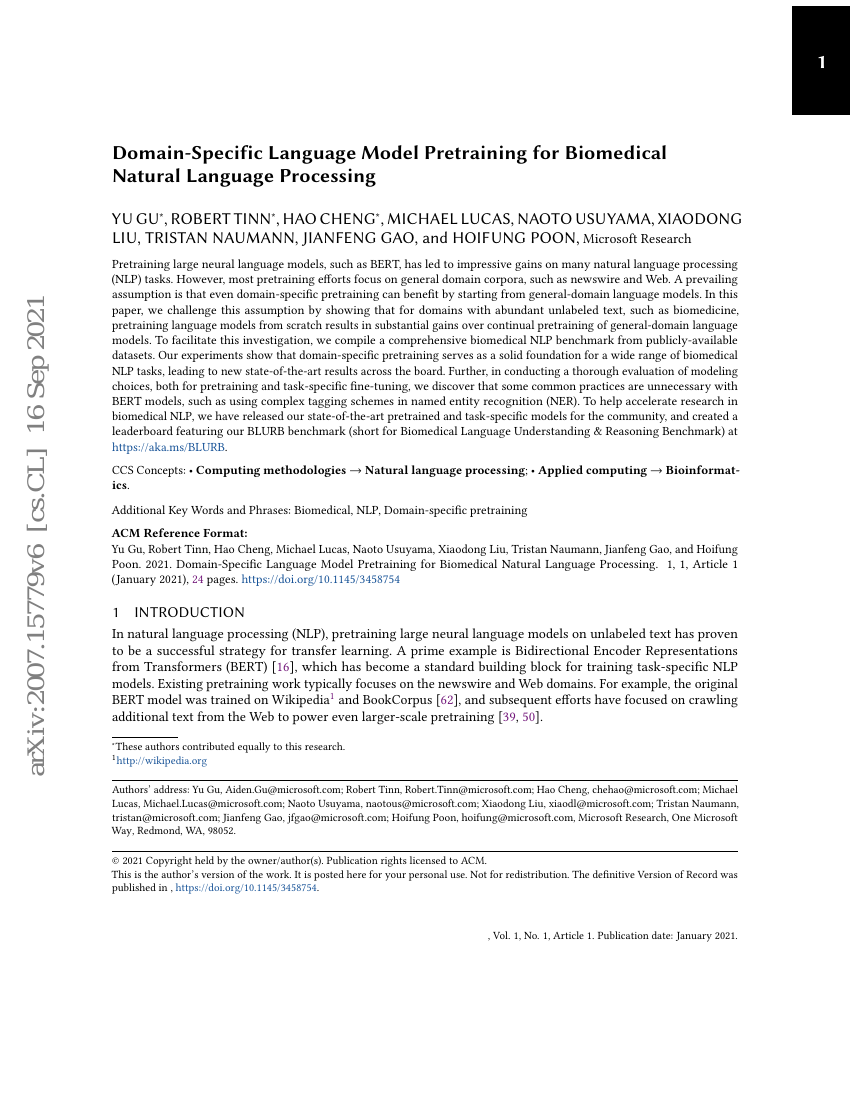Command Palette
Search for a command to run...
Domain-Specific Language Model Pretraining for Biomedical Natural Language Processing
Yu Gu; Robert Tinn; Hao Cheng; Michael Lucas; Naoto Usuyama; Xiaodong Liu; Tristan Naumann; Jianfeng Gao; Hoifung Poon

Abstract
Pretraining large neural language models, such as BERT, has led to impressive gains on many natural language processing (NLP) tasks. However, most pretraining efforts focus on general domain corpora, such as newswire and Web. A prevailing assumption is that even domain-specific pretraining can benefit by starting from general-domain language models. In this paper, we challenge this assumption by showing that for domains with abundant unlabeled text, such as biomedicine, pretraining language models from scratch results in substantial gains over continual pretraining of general-domain language models. To facilitate this investigation, we compile a comprehensive biomedical NLP benchmark from publicly-available datasets. Our experiments show that domain-specific pretraining serves as a solid foundation for a wide range of biomedical NLP tasks, leading to new state-of-the-art results across the board. Further, in conducting a thorough evaluation of modeling choices, both for pretraining and task-specific fine-tuning, we discover that some common practices are unnecessary with BERT models, such as using complex tagging schemes in named entity recognition (NER). To help accelerate research in biomedical NLP, we have released our state-of-the-art pretrained and task-specific models for the community, and created a leaderboard featuring our BLURB benchmark (short for Biomedical Language Understanding & Reasoning Benchmark) at https://aka.ms/BLURB.
Code Repositories
Benchmarks
| Benchmark | Methodology | Metrics |
|---|---|---|
| document-classification-on-hoc | PubMedBERT uncased | Micro F1: 82.32 |
| drug-drug-interaction-extraction-on-ddi | PubMedBERT | F1: 0.8236 Micro F1: 82.36 |
| named-entity-recognition-ner-on-jnlpba | PubMedBERT uncased | F1: 79.1 |
| named-entity-recognition-ner-on-ncbi-disease | PubMedBERT uncased | F1: 87.82 |
| named-entity-recognition-on-bc2gm | PubMedBERT uncased | F1: 84.52 |
| participant-intervention-comparison-outcome | PubMedBERT uncased | F1: 73.38 |
| pico-on-ebm-pico | PubMedBERT uncased | Macro F1 word level: 73.38 |
| question-answering-on-bioasq | PubMedBERT uncased | Accuracy: 87.56 |
| question-answering-on-blurb | PubMedBERT (uncased; abstracts) | Accuracy: 71.7 |
| question-answering-on-pubmedqa | PubMedBERT uncased | Accuracy: 55.84 |
| relation-extraction-on-chemprot | PubMedBERT uncased | Micro F1: 77.24 |
| relation-extraction-on-ddi | PubMedBERT uncased | Micro F1: 82.36 |
| relation-extraction-on-gad | PubMedBERT uncased | Micro F1: 82.34 |
| text-classification-on-blurb | PubMedBERT (uncased; abstracts) | F1: 82.32 |
Build AI with AI
From idea to launch — accelerate your AI development with free AI co-coding, out-of-the-box environment and best price of GPUs.